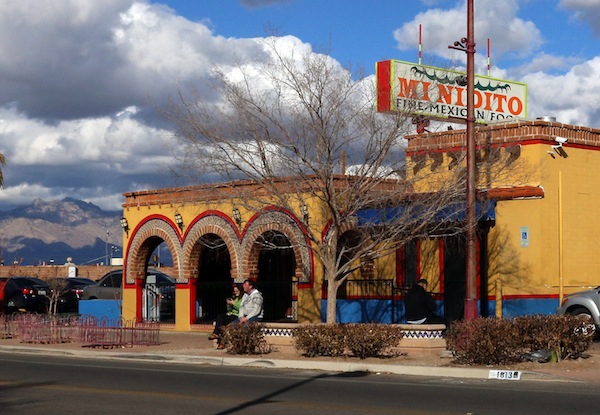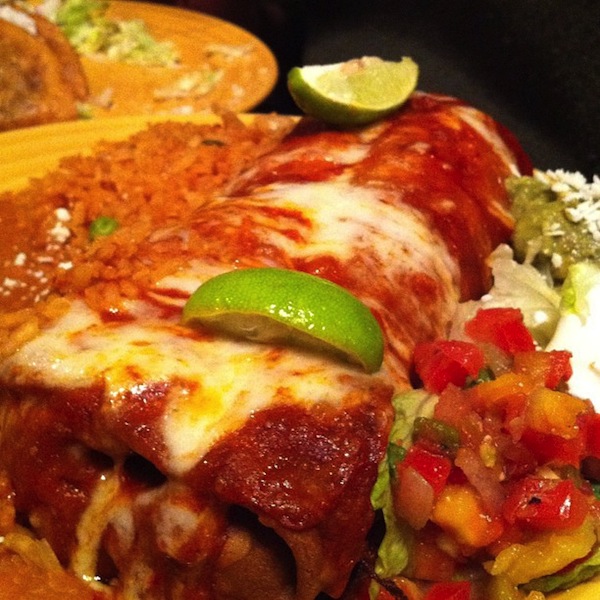
One afternoon while I was navigating the clogged freeways of Phoenix, a fierce argument erupted in the back of my car.
“Of course the chimichanga was invented in Tucson!” yelled one Tucsonan.
“No way,” replied the Phoenix native. “I am positive it’s from south Phoenix.”
“Perhaps it’s from Mexico?” chimed in an ever-neutral Illinois transplant in the front passenger seat.
I sat behind the driver’s wheel lost in thought, stumped by our chimichanga standoff. What is essentially a fried burrito was a staple of the restaurants I grew up with in Tucson. If not listed as a direct menu item, you could always request that your “bean and cheese” or “carne asada” be deep-fried. I had always assumed that, like tacos, enchiladas, or any other heralded tortilla-based platter, the chimichanga came from south of the border. However, my fellow Tucsonan adamantly claimed otherwise: The chimichanga was an American creation, boasting the best of both nations—the eclectic fixings and convenient shape of the Mexican burrito and the deep-fried exterior of American comfort foods. In her telling, the chimichanga was our state’s answer to Tex-Mex and New Mexican cuisine next door—another example of borderlands fusion.
The more I contemplated the chimichanga, the more it came to symbolize my home city. First a Spanish missionary outpost and later an outright Mexican town, Tucson has never forgotten its Hispanic core. Spanish words are found in street names, billboards, and food menus across the city. Tucson is even home to the longest-running mariachi festival outside of Mexico. From the outside, the fried burrito that is Tucson has the appearance of many other southwest American cities; however, its insides are more Mexican than most.
Even though I grew up in a thoroughly “gringo” household, I, like all the Tucsonans I know, feel a deep kinship with America’s southern neighbor. As long as I can remember, chips and salsa were the de facto snack at our place; Mexican food was the only cuisine that all family members would agree to eat. It was no coincidence that, in a family of runners, our favorite annual bonding event was the Tucson Cinco de Mayo 10K road race, which boasts an all-you-can-eat spread of five different burritos at the finish line. And so, the thought of the chimichanga being a Tucson original, a testament to the genius of the American culinary melting pot, was exciting. I set out to investigate.
Being a tech-savvy and lazy millennial, I started, naturally, with Wikipedia. The first line of the webpage regarding the history of the food mirrored the argument from my car: “Debate over the origins of the chimichanga is ongoing.” My heart sank. Numerous Mexican and Mexican-American grandparents were trying to take credit for the original recipe. One section asserted that the chimichanga was invented in Phoenix in 1946, following a cooking experiment by Woody Johnson, founder of the still-thriving Macayo’s restaurants.
Multiple other sources attributed the origin of the chimichanga to Tucson’s El Charro Café, the nation’s oldest Mexican restaurant in operation by the same family. As the El Charro nativity tale goes, the chimichanga and its curious name were born shortly after Monica Flin opened the restaurant in 1922. One afternoon, Tia Monica was frying taco shells and accidentally knocked a nearby burrito into the hot oil. When the burning liquid splashed onto her body, Tia Monica let out a common Spanish expletive that she barely managed to censor in the presence of her nephews to “Chi … michanga.” (Think back to when your mother would burn her hand on the stove and yell “Fuuuuu … dge!”) One accidentally crisped burrito and one cleverly curtailed cuss word later, the chimichanga became a new favorite in Tia Monica’s culinary arsenal.
I decided to do some sleuthing of my own on a trip to visit my family in Tucson. I dragged my parents and sister into the heart of south Tucson to visit one of the city’s star Mexican establishments: Mi Nidito. On its walls, Mi Nidito proudly displays signed photographs of visits from President Bill Clinton, Secretary of State Madeleine Albright, and celebrities like William Shatner, Linda Ronstadt, and Enrique Iglesias. Sadly, the Saturday night we went out, Mi Nidito’s wait line wrapped around the block. With our stomachs grumbling, we settled for dinner at a lesser-known but nonetheless stellar establishment down the street, Los Portales. After a bountiful dinner with many rounds of chips and margaritas, I spoke to the restaurant’s night manager, Celia Gongora, who was born and raised in the northern Mexican state of Sonora. Regarding the legacy of the fried burrito, she said that chimichangas are undoubtedly from Mexico.
“I grew up eating chimichangas as a young girl in Sonora,” she recalled. “The chimichangas in Mexico are smaller than the ones here, but they have definitely been around longer.”
Later conversations I had with other Mexico natives backed up the manager’s assertion, but the claims seemed more emotional than evidence-based.
“There is no way any American could create something as tasty as the chimichanga,” one Mexican friend stated, as if to end the discussion.
Confused and desperate for an authoritative opinion on at least the national ancestry of chimichangas, I called the Mexican consulate in Tucson. I spoke with a Mexican diplomat, Jonathan Granados Muñoz, whose job presumably entails more than fielding random phone queries from Anglo Mexicophiles. When I asked him about the food’s origin, he responded rather diplomatically, “I think it is a Mexican-American fusion dish.” He continued to explain that, while he thought the first chimichanga probably came from northern Mexico, he believed that the dish had risen to fame through its American variants.
So even Mexican diplomats posted in Arizona were willing to concede that, though the dish likely originated in Mexico, it was the U.S. that had most vocally adopted the food as its own, in a fashion not unlike America’s enthusiastic embrace of the Cinco de Mayo holiday. Regardless of its original Mexican sourcing, the chimichanga has become emblematic of the blending of cultural traditions that marks American food as a distinctly fusion cuisine.
And if “El Norte” seems most enthusiastic about claiming parentage of the chimichanga, no city wants to be more associated with it than Tucson. The city’s tourism office even went as far as publishing an ad in the nationally circulated Food & Wine magazine, inviting Americans to visit Tucson, “home of the chimichanga.”
I ended my exhausted pursuit of chimichanga truth with a pilgrimage to the food’s most likely birthplace: the El Charro Café in downtown Tucson. Relishing the sharp crunch of my knife slicing through the burrito’s crispy outer shell, I quickly forgot about its contested origins. The most important thing in that moment was that the chimichanga existed, and that it would soon find a new home—inside my stomach.





Send A Letter To the Editors